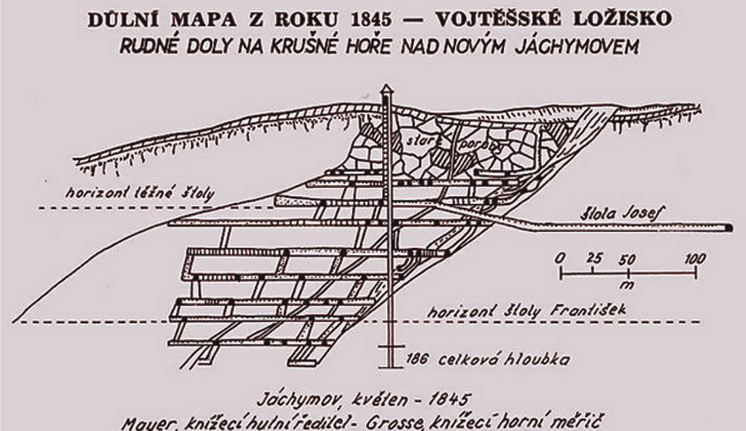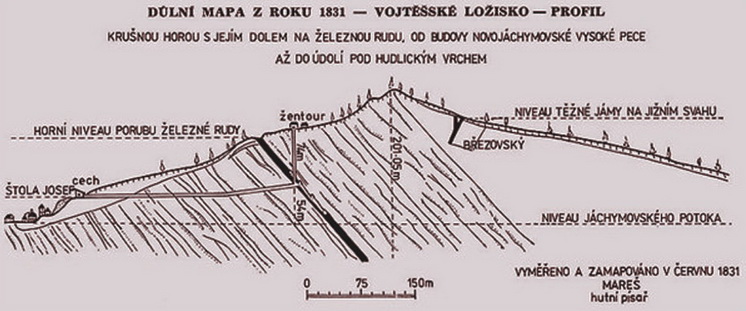Iron ore mine of Krušná Hora – part 2

Owners and holders
The mine changed several owners, among them were, for example, the Ott Family of Los, the Wallensteins, and Jan of Lobkovice. It was not until 1729 that it fell into the hands of the Fürstenbergs, together with the Křivoklát estate. For Krušná Hora, this was the beginning of a great development of mining and the beginning of mining of deeper positions of the deposit below the groundwater level. The first hereditary adit was founded in 1772, today’s the Adit of Josef in Nový Jáchymov.
During the 18th century there were two units on the territory of the ironworks in Podbrdy, the Chamber Ironworks of Zbiroh and the Fürstenberg Ironworks of Křivoklát. In 1842, the mining councillor of the Příbram Mining Authority declared: “… the great thickness of the deposit, the purity of the ore and at the same time the large directional and inclined range of ore positions put Krušná Hora in the first place among all Zbiroh iron ore mines.”
In 1827, Antonín Mayer became the director of the ironworks, who introduced a number of measures that contributed to the profitability of the entire company. Between 1849 and 1852, an average of 7,500 tons of ore was mined annually with 65 workers. Thanks to the opening of the opencast mine for pelosiderite, the annual extraction between 1867 and 1869 increased to 17,500 tons of ore with 113 workers. Krušná Hora ore accounted for 46% of the charge in all nine Fürstenberg blast furnaces. The Fürstenberg business ended at the same time as the cessation of the entire ironworks business (i.e. including the state business) during the years of the world economic crisis in the years 1873 to 1876.
After some time, the entire property became the property of the Czech Mining Company, but this did not change the fate of the plant. The mine no longer recovered from the consequences of the economic crisis and the flood, which in the 1880s severely affected the Zbiroh and Křivoklát regions in particular. The operation was constantly restricted and finally closed in 1889.

After ten years, the mining work on Krušná Hora was resumed, following the merger of the Czech Mining Company with the Prague Ironworks Company. During the First World War, the missing miners were partially replaced by Russian prisoners of war as well as horses, and the plant employed several women to sort the ore. After the end of the war, the industry needed to be rebuilt quickly, and therefore the volume of mining increased rapidly. Unfortunately, this period lasted barely three years, ore sales fell sharply and mining had to be stopped.
After a two-year break, there was an unprecedented boom in mining, the sorting of the hematite from the waste tips began, and the mining field expanded. The average annual extraction of 10,190 tons and 800 tons of sorted ore was achieved. Another global economic crisis also resulted in the complete cessation of work on Krušná Hora. The operation of the mine was fully resumed only due to the increased requirements of the arms industry in 1936.
After the end of World War II, the last period of activity of the Krušná Hora mine followed. In the early 1950s, large capital construction began, surface buildings were reconstructed and completed, transport in the mine was modernized and extensive geological research was carried out. Also, the drinking water supply and sewage disposal plants were built, and the construction of housing estates and small houses expanded. The mining reached its peak in the years 1957 to 1961, when the annual mining production climbed over 385 thousand tons of ore.
A government resolution decided to stop inefficient mining operations in April 1965. In Krušná Hora, lower-quality ore with low metallicity and high quartz content was mined, so it was not optimal for use as a direct blast furnace charge. The most feasible processing at first seemed the Krupp–Renn process, but even this method proved to be problematic. Therefore, the operation was completely closed on January 1, 1968.
Source: Lomy a těžba
